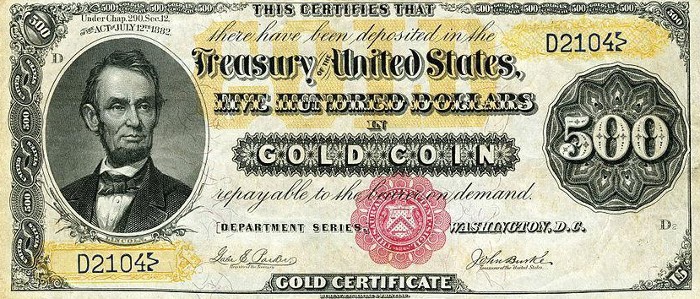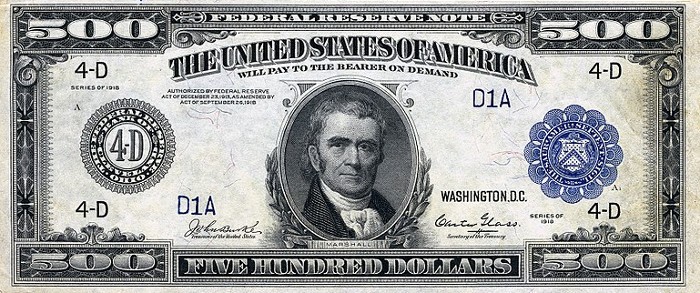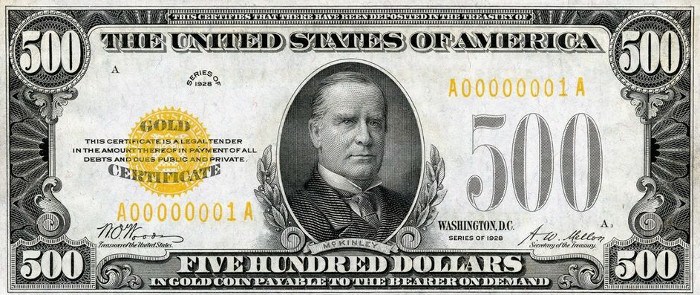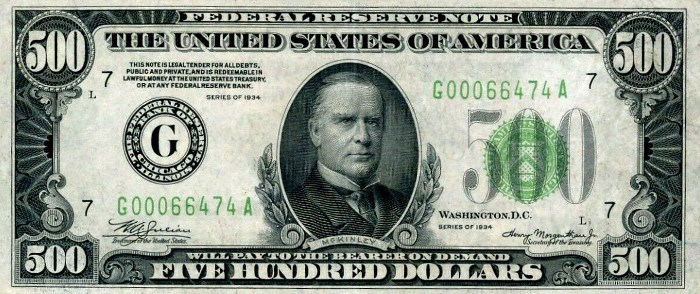The 500 dollar bill is a real United States currency bill that is long out of circulation. These bills are now collector's items and they can be quite valuable. Keep reading to learn more about these old bills, the different series, and what they are valued at.
Who Is on the 500 Dollar Bill?
There were several different issues of the 500 dollar bill so multiple people appeared on the front of them. However, the most common issue varieties feature president William McKinley on the front. So Mckinney is the person commonly thought of as the face of the 500 dollar bill.
President Abraham Lincoln was featured on the 1882 and 1922 gold certificates but these bills are far less common.
History
The 500 Dollar Bills were not specialty notes. In fact, they have a long history as United States currency. The first of these notes were issued in 1780 by the Province of North Carolina and later Virginia started printing their own large denomination bills. 500 dollar bills were also popular during the Civil War.
When the federal bank notes started to get issued back in 1861, the large denomination bills had a three year interest bearing period. These were essentially Treasury Notes, because they were a short-term loan to the government. Even back in the day, you would hardly ever see these notes in circulation. They were made for only large purchases and down-payments. So for that reason they were mostly used by banks.
Large denomination bills such as the 500 dollar bill, 1000 dollar bill, 5,000 dollar bill, and 10,000 dollar bill were last printed in 1945 and taken out of circulation in 1969 due to lack of usage. They are still considered to be legal tender today. However the collectible value of one of these bills will usually be much higher than the face value.
Value
There were more five hundred dollar bills printed then you might think. Of course they are out of circulation today but the government still printed many of these bills over the years. For that reason, the common $500 note series such as the 1928 and 1934 issues are not as valuable as other series.
The prices for the common issues are generally around $2,500 in extremely fine condition. If your bill has a star before the serial number (a star note) then it will be worth more money. However not every series has star notes. In addition, if you have a bill with a serial number under 100 then it will also be worth more money. For example B00000055A.
The extremely rare 500 dollar bill series only have a few bills known to be in existence, some of which are featured in museums. These extremely rare bills are worth as much as someone is willing to pay for them. But on the high end they can sell for a half-million dollars.
Most 500 dollar bills that exist today are in great condition. This is because back in the day, large denomination bills were used sparingly. However condition still plays a large role in determining the value of an individual bill.
Below we will take a closer look at six different series that you can find on the market.
Series
There were several different series issued but most are so rare that you won't ever come across them. Therefore we are only going to examine the six most common 500 dollar notes that you can find for sale.
1882 $500 Gold Certificate

This is a gold certificate with Abraham Lincoln on the front and it's one of the most common 500 dollar large notes. The 1882 $500 gold certificates weren't just printed in 1882- the government continued to print them for decades. Most large retail shops and online stores will have them available for sale.
Most 1882 series $500 gold certificates are worth around $5,350-7,500 in very good condition. In very fine condition the value is around $26,000. In extremely fine condition the price is around $48,000.
There are also rare signature combinations that can sell for over six figures. So if you have one of these bills then you'll want to get it checked out by an expert.
1918 $500 Federal Reserve Note

The back design on this bill is famous and appealing to collectors. The image on the back of the bill is called DeSoto Discovering The Mississippi. Hernando de Soto was a Spanish explorer who is credited with the discovery of the Mississippi River.
Most 1918 series $500 notes are worth around $4,250-5,000 in very good condition. In very fine condition the value is around $15,000-18,500. In extremely fine condition the price is around $22,500-30,000. Notes issued from the Federal Reserve Banks of Boston, Dallas, Minneapolis, Philadelphia, and San Francisco are worth more. Notes issued with the White and Mellon signature combination are also worth more.
1922 $500 Gold Certificate
The 1922 $500 Gold Certificate looks a lot similar to the 1882 version. The visual differences are minor so when in doubt just check the date. There are no varieties or star notes for this series so the value will be based on its condition.
The 1922 series $500 gold certificates are worth around $5,350 in very good condition. In very fine condition the value is around $26,000. In extremely fine condition the price is around $48,000.
1928 $500 Gold Certificate

1928 was the final year that the United States issued gold certificates. The government printed 420,000 1928 five hundred dollar gold certificates, which is a relatively high number. This series has no varieties so condition largely determines the value. In addition, serial numbers under 100 command a premium.
The 1928 series $500 gold certificates are worth around $2,750 in very good condition. In very fine condition the value is around $8,500. In extremely fine condition the price is around $15,000. In uncirculated condition the price is around $50,000 for gold certificates with an MS 63 grade.
1928 $500 Federal Reserve Note
Although these notes state on the front "redeemable in gold on demand", the 1928 $500 Federal Reserve notes are not gold certificates. These notes feature William McKinley on the front and they have the same look as the 1934 Federal Reserve note.
The value for these bills is determined by several different factors. Of course condition is important, but so is the serial number, bank of origin, and the seal color. There is a high demand for low serial numbers under 100 and notes issued from Boston are much more rare. Twelve different banks issued out these notes and three of them (the Chicago, New York,and Kansas City banks) printed out light green seals instead of dark green seals. The light green seals sell for a small premium.
Most 1928 series $500 notes are worth around $3,000 in extremely fine condition. In uncirculated condition the price is around $6,000 for notes with an MS 63 grade.
Star notes are also available and they are very rare and valuable.
1934 $500 Federal Reserve Note

There is the 1934 series Federal Reserve note and the 1934A series Federal Reserve note. There isn't any significant difference in price between the two series. Almost two million 1934 500 dollar bills were printed and there are estimated to be around 150,000 in existence. Therefore if you're in the market to buy a 500 dollar bill then you can buy one from this series at a reasonable price. Also note that the 1934 bills with light green seals (LGS) sell for a premium.
Most 1934 and 1934A series $500 notes are worth around $2,500 in extremely fine condition. In uncirculated condition the price is around $5,500 for notes with an MS 63 grade.
Most 1934 and 1934A series $500 star notes are worth around $6,500 in extremely fine condition. In uncirculated condition the price is around $18,500 for notes with an MS 63 grade. Star notes issued from the Federal Reserve Banks of Minneapolis, Kansas City, and Dallas are worth more.
Grading System
Very good- A circulated note that has considerable wear to it. There might be one or two tears on the edge of the note. The note may be discolored, dark in appearance, or limp.
Very fine- A note that has been in circulation but not for a long time. The note is still relatively crisp. There may be some creases, folds, or light smudges.
Extremely fine- A note that shows small signs of having been in circulation. The note will be bright and it will have almost all of its original crispness. There might be one or two minor creases or folds but there are no stains, discolorations, or tears.
MS 63 uncirculated- A note that shows no signs of ever having been in circulation. The note still has its original crispness. The centering may not be perfect, and there might be one or more pinholes, smudges from counting, or other signs of improper handling.
Conclusion
If you have one of these bills then it would be prudent to do your own research and ideally have it checked out by an expert. An expert can tell you based on a few different factors (signature combination, bank or origin, etc) if your bill is one of the rare types.
Sources:
